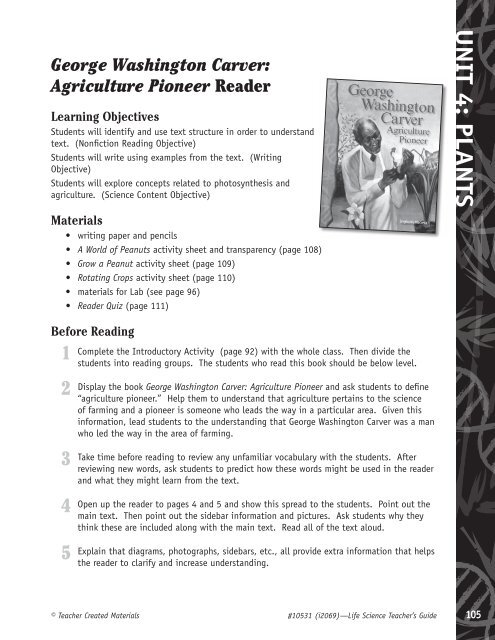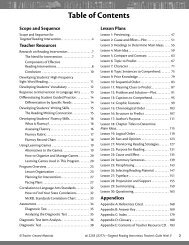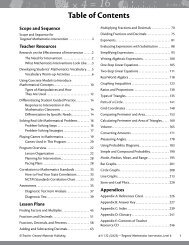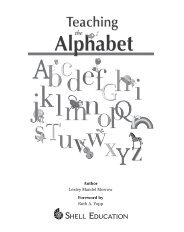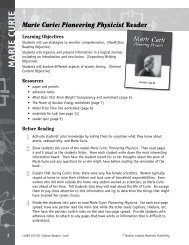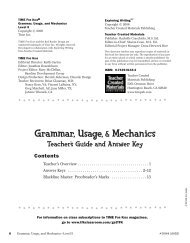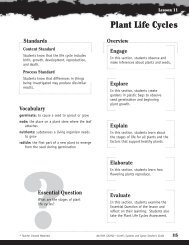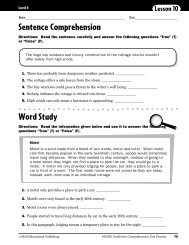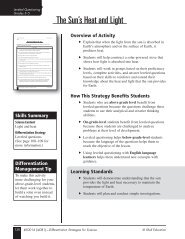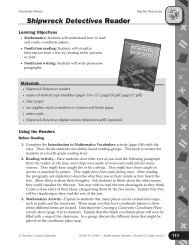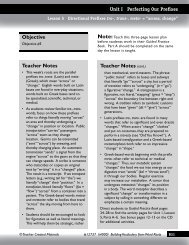George Washington Carver - Teacher Created Materials
George Washington Carver - Teacher Created Materials
George Washington Carver - Teacher Created Materials
You also want an ePaper? Increase the reach of your titles
YUMPU automatically turns print PDFs into web optimized ePapers that Google loves.
<strong>George</strong> <strong>Washington</strong> <strong>Carver</strong>:<br />
Agriculture Pioneer Reader<br />
Learning Objectives<br />
Students will identify and use text structure in order to understand<br />
text. (Nonfiction Reading Objective)<br />
Students will write using examples from the text. (Writing<br />
Objective)<br />
Students will explore concepts related to photosynthesis and<br />
agriculture. (Science Content Objective)<br />
<strong>Materials</strong><br />
• writing paper and pencils<br />
• A World of Peanuts activity sheet and transparency (page 108)<br />
• Grow a Peanut activity sheet (page 109)<br />
• Rotating Crops activity sheet (page 110)<br />
• materials for Lab (see page 96)<br />
• Reader Quiz (page 111)<br />
Unit 4: Plants<br />
Before Reading<br />
1<br />
2<br />
3<br />
4<br />
5<br />
Complete the Introductory Activity (page 92) with the whole class. Then divide the<br />
students into reading groups. The students who read this book should be below level.<br />
Display the book <strong>George</strong> <strong>Washington</strong> <strong>Carver</strong>: Agriculture Pioneer and ask students to define<br />
“agriculture pioneer.” Help them to understand that agriculture pertains to the science<br />
of farming and a pioneer is someone who leads the way in a particular area. Given this<br />
information, lead students to the understanding that <strong>George</strong> <strong>Washington</strong> <strong>Carver</strong> was a man<br />
who led the way in the area of farming.<br />
Take time before reading to review any unfamiliar vocabulary with the students. After<br />
reviewing new words, ask students to predict how these words might be used in the reader<br />
and what they might learn from the text.<br />
Open up the reader to pages 4 and 5 and show this spread to the students. Point out the<br />
main text. Then point out the sidebar information and pictures. Ask students why they<br />
think these are included along with the main text. Read all of the text aloud.<br />
Explain that diagrams, photographs, sidebars, etc., all provide extra information that helps<br />
the reader to clarify and increase understanding.<br />
© <strong>Teacher</strong> <strong>Created</strong> <strong>Materials</strong> #10531 (i2069)—Life Science <strong>Teacher</strong>’s Guide 105


